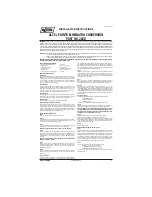
The electronically controlled ABS
maintains vehicle stability and control
during emergency braking by
preventing wheel lock-up. ABS
provides optimum deceleration and
stability during adverse conditions. It
automatically adjusts brake system
hydraulic pressure at each wheel to
prevent wheel lock-up.
The system's main components are the
wheel speed (pulse) sensors, the
ABS/ASC or ABS/DSC control module,
and the hydraulic control unit.
The wheel speed sensors continuously
send wheel speed signals to the
control module. The control module
compares these signals to determine,
in fractions of a second, whether any of
the wheels are about to lock. If any
wheel is nearing a lock-up condition,
the module signals the hydraulic unit to
maintain or reduce pressure at the
appropriate wheel(s). Pressure is
modulated by electrically-operated
solenoid valves in the hydraulic unit.
Automatic Stability Control
(ASC)
The Automatic Stability Control (ASC)
system works in conjunction with the
Antilock Brake System (ABS) and the
engine management system to
enhance vehicle control. The main
function of the ASC system is to
maintain the rolling contact between
the tires and the road surface under all
driving conditions. This is achieved
through exact application and
management of braking and drivetrain
forces.
Note:
The traction control system referred to
as ASC (Automatic Stability Control)
Suspension, Steering and Brakes — General
http://ebahn.bentleypublishers.com/BMW/3/E46/Repair%20Manuals/3...
4 of 24
2/25/2009 10:24 PM
















































